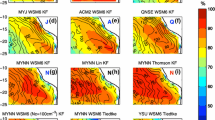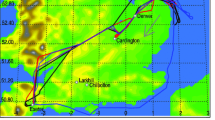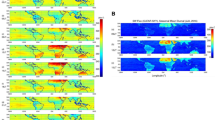Abstract
The spatial and temporal variance of stratocumulus cloud liquid water path (CLWP) over Southeastern Pacific has been investigated by combining satellite moderate resolution imaging spectroradiometer cloud products, CLWP from advanced microwave scanning radiometer-EOS observations and NCEP final analysis atmospheric products with empirical orthogonal function (EOF) Analysis. CLWP variance is the most complicated factor among three fundamental cloud quantities (the microphysical cloud droplet concentration, and the macrophysical CLWP and cloud fractional cover). The results show that EOF/PC1 of CLWP represents the variation of domain-averaged CLWP, which is mainly controlled by surface meteorological factors. Sea surface temperature and cold advection drive the synoptic and seasonal scales of variance of CLWP, while surface wind speed plays a fundamental role in stratocumulus cloud formation and daily variance of CLWP. EOF/PC2 of CLWP describes the spatial variance of CLWP. This daily spatial variance of CLWP is controlled by the factors of lower tropospheric stability and cloud top relative humidity, which determine cloud thickness and, consequently, CLWP through thermodynamic and entrainment processes. Further study indicates a twofold interaction of the surface wind speed on stratocumulus CLWP: (1) dynamically through modulation of surface latent heat and sensible heat fluxes and (2) microphysically through enhanced marine aerosol production.












Similar content being viewed by others
References
Ackerman AS, Kirkpatrick MP, Stevens DE, Toon OB (2004) The impact of humidity above stratiform clouds on indirect aerosol climate forcing. Nature 432:1014–1017
Albrecht BA (1989) Aerosols, cloud microphysics, and fractional cloudiness. Science 245:1227–1230
Beckers J, Rixen M (2003) EOF calculations and data filling from incomplete oceanographic datasets. J Atmos Ocean Technol 20:1839–1856
Bony S, Dufresne J-L (2005) Marine boundary layer clouds at the heart of tropical cloud feedback uncertainties in climate models. Geophys Res Lett 32:L20806. doi:10.1029/2005GL023851
Bretherton CS, Wyant MC (1997) Moisture transport, lower-tropospheric stability, and decoupling of cloud-topped boundary layers. J Atmos Sci 54:148–167
Bretherton CS, Uttal T, Fairall CW, Yuter SE, Weller RA, Baumgardner D, Comstock K, Wood R, Raga GB (2004) The EPIC 2001 stratocumulus study. Bull Am Meteorol Soc 85:976–977. doi:10.1175/bams-85-7-967
Caldwell P, Bretherton CS (2009) Response of a subtropical stratocumulus-capped mixed layer to climate and aerosol changes. J Clim 22:20–38
Considine G, Curry JA, Wielicki B (1997) Modeling cloud fraction and horizontal variability in marine boundary layer clouds. J Geophys Res Atmos 102:13517–13525. doi:10.1029/97JD00261
Dal Gesso S, Siebesma A, de Roode S, van Wessem J (2011) A mixed-layer model perspective on stratocumulus steady-states in a perturbed climate. Q J R Meteorol Soc. doi:10.1002/qj.2282
George R, Wood R (2010) Subseasonal variability of low cloud radiative properties over the southeast Pacific Ocean. Atmos Chem Phys 10:4047–4063. doi:10.5194/acp-10-4047-2010
Kalnay E et al (1996) The NCEP/NCAR 40-year reanalysis project. Bull Am Meteorol Soc 77:437–471
Klein SA (1997) Synoptic variability of low-cloud properties and meteorological parameters in the subtropical trade wind boundary layer. J Clim 10:2018–2039
Klein SA, Hartmann DL (1993) The seasonal cycle of low stratiform clouds. J Clim 6:1587–1606
Klein SA, Hartmann DL, Norris JR (1995) On the relationships among low-cloud structure, sea surface temperature, and atmospheric circulation in the summertime northeast Pacific. J Clim 8:1140–1155
Latham J, Smith M (1990) Effect on global warming of wind-dependent aerosol generation at the ocean surface. Nature 347:372–373
Lin W, Zhang M, Loeb NG (2009) Seasonal variation of the physical properties of marine boundary layer clouds off the California coast. J Clim 22:2624–2638
Lohmann U, Feichter J (2005) Global indirect aerosol effects: a review. Atmos Chem Phys 5:715–737. doi:10.5194/acp-5-715-2005
Mauri E, Poulain PM, Južnič-Zonta Ž (2007) MODIS chlorophyll variability in the northern Adriatic Sea and relationship with forcing parameters. J Geophys Res Oceans 112:C03S11. doi:10.1029/2006JC003545
Min Q et al (2012) Comparison of MODIS cloud microphysical properties with in situ measurements over the Southeast Pacific. Atmos Chem Phys 12:11261–11273. doi:10.5194/acp-12-11261-2012
Myers TA, Norris JR (2013) Observational evidence that enhanced subsidence reduces subtropical marine boundary layer cloudiness. J Clim 26:7507–7524
Norris JR, Leovy CB (1994) Interannual variability in stratiform cloudiness and sea surface temperature. J Clim 7:1915–1925
O’Dowd CD, Lowe JA, Smith MH, Kaye AD (1999) The relative importance of non-sea-salt sulphate and sea-salt aerosol to the marine cloud condensation nuclei population: an improved multi-component aerosol-cloud droplet parametrization. Quarterly Journal of the Royal Meteorological Society 125:1295–1313
Rahn D, Garreaud R (2010) Marine boundary layer over the subtropical southeast Pacific during VOCALS-REx–Part 1: mean structure and diurnal cycle. Atmos Chem Phys 10:4491–4506. doi:10.5194/acp-10-4491-2010
Stevens B, Brenguier J-L (2009) Cloud controlling factors—low clouds. In: Heintzenberg J, Charlson RJ (eds) Clouds in the perturbed climate system, 1st edn. MIT Press, Cambridge, pp 173–196
Stevens B, Feingold G (2009) Untangling aerosol effects on clouds and precipitation in a buffered system. Nature 461:607–613
Szczodrak M, Austin PH, Krummel P (2001) Variability of optical depth and effective radius in marine stratocumulus clouds. J Atmos Sci 58:2912–2926
Wang Y, Xie S-P, Xu H, Wang B (2004a) Regional model simulations of marine boundary layer clouds over the Southeast Pacific off South America. Part I: control experiment. Mon. Wea. Rev. 132:274–296
Wang Y, Xu H, Xie S-P (2004b) Regional model simulations of marine boundary layer clouds over the Southeast Pacific off South America. Part II: sensitivity experiments. Mon. Wea. Rev. 132:2650–2668
Wang Y, Xie S-P, Wang B, Xu H (2005) Large-scale atmospheric forcing by Southeast Pacific boundary-layer clouds: a regional model study. J Clim 18:934–951
Wang L, Wang Y, Lauer A, Xie S-P (2011) Simulation of seasonal variation of marine boundary layer clouds over the eastern Pacific with a regional climate model. J Clim 24:3190–3210
Weare BC (1994) Interrelationships between cloud properties and sea surface temperatures on seasonal and interannual time scales. J Clim 7:248–260
Wilks DS (2006) Statistical methods in the atmospheric sciences. Elsevier, Amsterdam
Wood R, Bretherton C, Hartmann D (2002) Diurnal cycle of liquid water path over the subtropical and tropical oceans. Geophys Res Lett 29:2092. doi:10.1029/2002GL015371
Wood R, Mechoso CR, Bretherton CS, Weller RA, Huebert B, Straneo F, Albrecht BA, Coe H, Allen G, Vaughan G, Daum P, Fairall C, Chand D, Gallardo Klen-ner L, Garreaud R, Grados C, Covert DS, Bates TS, Krejci R, Russell LM, de Szoeke S, Brewer A, Yuter SE, Springston SR, Chaigneau A, Toniazzo T, Min-nis P, Palikonda R, Abel SJ, Brown WOJ, Williams S, Fochesatto J, Brioude J, Bower KN (2011) The VAMOS ocean-cloud-atmosphere-land study regional experiment (VOCALS-REx): goals, platforms, and field operations. Atmos Chem Phys 11:627–654. doi:10.5194/acp-11-627-2011
Xu H, Wang Y, Xie S-P (2004) Effects of the Andes on eastern Pacific climate: a regional atmospheric model study. J Climate 17:589–602
Xu H, Xie S-P, Wang Y (2005) Subseasonal variability of the Southeast Pacific Stratus Cloud Deck. J Clim 18:131–142
Acknowledgments
This work was supported by US NSF under contract AGS-1138495, by the DOE’s Atmospheric System Research program (Office of Science, OBER) under contract DE-FG02-03ER63531, and by the NOAA Educational Partnership Program with Minority Serving Institutions (EPP/MSI) under cooperative agreements NA17AE1625 and NA17AE1623, and supported by Science and Technology Research Foundation of SGCC contract DZB17201200260.
Author information
Authors and Affiliations
Corresponding author
Additional information
Responsible Editor: S. Hong.
Rights and permissions
About this article
Cite this article
Min, L., Gong, W., Liu, G. et al. Understanding the synoptic variability of stratocumulus cloud liquid water path over the Southeastern Pacific. Meteorol Atmos Phys 127, 625–634 (2015). https://doi.org/10.1007/s00703-015-0392-2
Received:
Accepted:
Published:
Issue Date:
DOI: https://doi.org/10.1007/s00703-015-0392-2




